Alteration of Nitrogen Fertilizer Forms Optimizes Nitrogen Balance in Drip-Irrigated Winter Wheat Systems of Northern China by Reducing Gaseous Nitrogen Losses
Abstract
1. Introduction
2. Materials and Methods
2.1. Experimental Site
2.2. Field Management and Experimental Design
2.3. Measurements and Calculation Methods
2.3.1. Soil NO3−-N and NH4+-N Measurement
2.3.2. Measurement of N2O Flux
2.3.3. Measurement of NH3 Volatilization
2.3.4. Leaf Area Index, Dry Matter Accumulation, and Plant N Measurements
2.3.5. Grain Yield and Yield Component Measurement
2.3.6. Calculation of Harvest Index, N Harvest Index, and NUE
2.3.7. N Balance Calculation
2.4. Statistical Analysis
3. Results
3.1. Soil NO3−-N and NH4+-N
3.2. N2O Flux and NH3 Volatilization
3.3. LAI and Dry Matter
3.4. Winter Wheat Yield and NUE
3.5. N Balance
3.6. Correlation Analysis
4. Discussion
4.1. N2O Fluxes and NH3 Volatilization Under Different N Fertilizer Forms in Winter Wheat Fields
4.2. Yield and NUE Under Different N Fertilizer Forms in Winter Wheat
4.3. N Balance Under Different N Fertilizer Forms in Winter Wheat
5. Conclusions
Author Contributions
Funding
Institutional Review Board Statement
Data Availability Statement
Conflicts of Interest
Abbreviations
| NON | Nitrate N fertilizer |
| NHN | Ammonium N fertilizer |
| CON | Amide N fertilizer |
| UAN | Urea ammonium nitrate |
| CK | Control |
| WUE | Water use efficiency |
| N | Nitrogen |
| NUE | Nitrogen use efficiency |
| N2O | Nitrous oxide |
| NH3 | Ammonia |
| NO3−-N | Nitrate |
| NH4+-N | Ammonium |
| LAI | Leaf area index |
| HI | Harvest index |
| NHI | Nitrogen harvest index |
| LSD | Least significant difference |
References
- Wang, H.; Wu, J.; Li, G.; Yuan, J. Influence of Nitrogen Addition Levels on N2O Flux and Yield of Spring Wheat in the Loess Plateau. Agronomy 2025, 15, 1377. [Google Scholar] [CrossRef]
- Tong, J.; Xiong, Y.; Lu, Y.; Li, W.; Lin, W.; Xue, J.; Sun, M.; Wang, Y.; Gao, Z. Drip Fertigation Enhances the Responses of Grain Yield and Quality to Nitrogen Topdressing Rate in Irrigated Winter Wheat in North China. Plants 2024, 13, 1439. [Google Scholar] [CrossRef]
- Yu, Y.; Liu, Z.; Zhang, Y.; Su, Z.; Jian, H.; Gao, J.; Hartmann, R.; Gabriels, D. Yield of winter wheat in the Chinese Loess Plateau depends strongly on precipitation seasonality. Sci. Rep. 2025, 15, 5344. [Google Scholar]
- Tong, J.; Xiong, Y.; Lu, Y.; Li, W.; Xue, J.; Sun, M.; Wang, Y.; Gao, Z. Drip fertigation enhances the responses of grain yield, nitrogen and water use efficiency, and quality of irrigated winter wheat in northern China to nitrogen application. Front. Plant Sci. 2024, 15, 1372385. [Google Scholar]
- Lu, J.; Hu, T.; Geng, C.; Cui, X.; Fan, J.; Zhang, F. Response of yield, yield components and water–nitrogen use efficiency of winter wheat to different drip fertigation regimes in Northwest China. Agric. Water Manag. 2021, 255, 107034. [Google Scholar] [CrossRef]
- Li, H.; Mei, X.; Nangia, V.; Guo, R.; Liu, Y.; Hao, W.; Wang, J. Effects of different nitrogen fertilizers on the yield, water-and nitrogen-use efficiencies of drip-fertigated wheat and maize in the North China Plain. Agric. Water Manag. 2021, 243, 106474. [Google Scholar] [CrossRef]
- Recous, S.; Machet, J.M.; Mary, B. The fate of labelled15N urea and ammonium nitrate applied to a winter wheat crop: II. plant uptake and N efficiency. Plant Soil 1988, 112, 215–224. [Google Scholar] [CrossRef]
- Li, H.; Mei, X.; Wang, J.; Huang, F.; Hao, W.; Li, B. Drip fertigation significantly increased crop yield, water productivity and nitrogen use efficiency with respect to traditional irrigation and fertilization practices: A meta-analysis in China. Agric. Water Manag. 2021, 244, 106534. [Google Scholar] [CrossRef]
- Govindasamy, P.; Muthusamy, S.K.; Bagavathiannan, M.; Mowrer, J.; Jagannadham, P.; Maity, A.; Halli, H.; Sujayanand, G.; Vadivel, R.; Das, T.; et al. Nitrogen use efficiency—A key to enhance crop productivity under a changing climate. Front. Plant Sci. 2023, 14, 1121073. [Google Scholar] [CrossRef]
- Zhai, W.; Cheng, Q.; Duan, F.; Huang, X.; Chen, Z. Remote sensing-based analysis of yield and water-fertilizer use efficiency in winter wheat management. Agric. Water Manag. 2025, 311, 109390. [Google Scholar] [CrossRef]
- Wang, S.; Wang, D.; Liu, T.; Liu, Y.; Luo, M.; Li, Y.; Zhou, W.; Yang, M.; Liang, S.; Li, K. Simulation of winter wheat growth dynamics and optimization of water and nitrogen application systems based on the aquacrop model. Agronomy 2024, 14, 110. [Google Scholar] [CrossRef]
- Shi, C.; Liao, A.; Du, C.; Li, L.; Wan, X.; Liu, Y. Optimal Effect of Substituting Organic Fertilizer for Inorganic Nitrogen on Yield and Quality of Winter Wheat under Drip Irrigation. Agronomy 2024, 14, 2012. [Google Scholar] [CrossRef]
- Lang, Y.; Wu, Y.; Bao, H.; Tuya, N.; Liu, F.; Ruhan, A.; Wu, X.; Yang, J.; Qi, L.; Wang, X. Seasonal variation of N2O flux at the water air interface and its influencing factors in the Inner Mongolia section of the Yellow River in 2023. J. Freshw. Ecol. 2025, 40, 2501974. [Google Scholar] [CrossRef]
- Gao, W.; Wang, X.; Jian, Z.; Chen, Y.; Ni, X.; Wang, J.; Dong, Y.; Li, Z.; Cao, B. Effects of Controlled-release Blended Fertilizer on Crop Yield and Greenhouse Gas Emissions in Wheat-maize Rotation System. Huan Jing Ke Xue Huanjing Kexue 2024, 45, 2891–2904. [Google Scholar]
- Seçer, M.; Elmaci, Ö.L.; Erdemir, O. Does the ammonium fixation capacity of soils have a significant effect on the nitrogen nutrition of wheat? Commun. Soil Sci. Plant Anal. 2011, 42, 1606–1618. [Google Scholar] [CrossRef]
- Bilge, U.; Çimrin, K.M. The effect of top dressing fertilizer forms applied at different periods on yield and some yield components in durum wheat varieties. Mustafa Kemal Üniversitesi Tarım Bilim. Derg. 2025, 30, 13–34. [Google Scholar] [CrossRef]
- Guo, C.; Wang, H.; Zou, D.; Wang, Y.; Han, X. A novel amended nitrification inhibitor confers an enhanced suppression role in the nitrification of ammonium in soil. J. Soils Sediments 2022, 22, 831–843. [Google Scholar] [CrossRef]
- Ramírez, G.B.; Miguel, C.; Montanha, G.S.; Carmona, F.J.; Dal Sasso, G.; Sillero, J.C.; Skov Pedersen, J.; Masciocchi, N.; Guagliardi, A.; Pérez-de-Luque, A. Reducing nitrogen dosage in Triticum durum plants with urea-doped nanofertilizers. Nanomaterials 2020, 10, 1043. [Google Scholar] [CrossRef] [PubMed]
- Si, Z.; Zain, M.; Li, S.; Liu, J.; Liang, Y.; Gao, Y.; Duan, A. Optimizing nitrogen application for drip-irrigated winter wheat using the DSSAT-CERES-Wheat model. Agric. Water Manag. 2021, 244, 106592. [Google Scholar] [CrossRef]
- Winkhart, F.; Schmid, H.; Hülsbergen, K.J. Effects of biogas digestate on winter wheat yield, nitrogen balance, and nitrous oxide emissions under organic farming conditions. Agronomy 2024, 14, 1739. [Google Scholar] [CrossRef]
- Wang, H.; Ma, S.; Shao, G.; Dittert, K. Use of urease and nitrification inhibitors to decrease yield-scaled N2O emissions from winter wheat and oilseed rape fields: A two-year field experiment. Agric. Ecosyst. Environ. 2021, 319, 107552. [Google Scholar] [CrossRef]
- Fu, Y.; Cui, Z.; Yao, J.; Ji, F.; Lu, W.; He, Z. Effects of water and nitrogen coupling on photosynthetic characteristics and yield of winter wheat in film hole irrigation fields. Desalination Water Treat. 2022, 268, 273–284. [Google Scholar] [CrossRef]
- Liu, X.; Liu, J.; Huang, C.; Liu, H.; Meng, Y.; Chen, S.; Ma, S.; Liu, Z. The impacts of irrigation methods and regimes on the water and nitrogen utilization efficiency in subsoiling wheat fields. Agric. Water Manag. 2024, 295, 108765. [Google Scholar] [CrossRef]
- Liu, Z.; Li, Z.; Huang, F.; Wang, B.; Zhao, C.; Zhang, P.; Jia, Z. Plastic film mulching and biochar amendment enhance maize yield and nitrogen fertilizer use efficiency by reducing gaseous nitrogen losses. Field Crops Res. 2022, 289, 108714. [Google Scholar] [CrossRef]
- Stella, P.; Loubet, B.; Laville, P.; Lamaud, E.; Cazaunau, M.; Laufs, S.; Bernard, F.; Grosselin, B.; Mascher, N.; Kurtenbach, R.; et al. Comparison of methods for the determination of NO-O3-NO2 fluxes and chemical interactions over a bare soil. Atmos. Meas. Tech. 2012, 5, 1241–1257. [Google Scholar] [CrossRef]
- Frame, W.H.; Alley, M.M.; Whitehurst, G.B.; Whitehurst, B.M.; Campbell, R.G. In vitro evaluation of coatings to control ammonia volatilization from surface-applied urea. Agron. J. 2012, 104, 1201–1207. [Google Scholar] [CrossRef]
- GB 1351-2023; Wheat. State Administration for Market Regulation National Standardization Administration: Beijing, China, 2023.
- Tao, Z.; Tao, L.; Cao, F.; Chen, J.; Yin, X.; Liang, T.; Huang, M. Contrasting characteristics of lodging resistance in two super-rice hybrids differing in harvest index. Phyton 2022, 91, 429. [Google Scholar] [CrossRef]
- Haile, D.; Nigussie, D.; Ayana, A. Nitrogen use efficiency of bread wheat: Effects of nitrogen rate and time of application. J. Soil Sci. Plant Nutr. 2012, 12, 389–410. [Google Scholar] [CrossRef]
- Liu, Z.; Gao, J.; Gao, F.; Dong, S.; Liu, P.; Zhao, B.; Zhang, J. Integrated agronomic practices management improve yield and nitrogen balance in double cropping of winter wheat-summer maize. Field Crops Res. 2018, 221, 196–206. [Google Scholar] [CrossRef]
- Gao, Q.; Zhang, X.; Liu, L.; Lu, X.; Wang, Y. A database of atmospheric inorganic nitrogen deposition fluxes in China from satellite monitoring. Sci. Data 2023, 10, 698. [Google Scholar] [CrossRef]
- Guo, D.; Wang, R.; Chen, C.; Yin, B.; Ding, Z.; Wang, X.; Zhao, M.; Zhou, B. Nitrogen supply mitigates heat stress on photosynthesis of maize (Zea mays L.) during early grain filling by improving nitrogen assimilation. J. Agron. Crop Sci. 2024, 210, e12750. [Google Scholar] [CrossRef]
- Li, W.; Yao, L.; Long, M.; Zhang, H.; Zhang, Y.; Wen, X.; Mo, F.; Han, J.; Liao, Y. Biochar reduced soil N losses and improved N balance in a rainfed winter-wheat cropping agroecosystem. Appl. Soil Ecol. 2022, 179, 104591. [Google Scholar] [CrossRef]
- Huang, M.; Liang, T.; Ou-Yang, Z.; Wang, L.; Zhang, C.; Zhou, C. Leaching losses of nitrate nitrogen and dissolved organic nitrogen from a yearly two crops system, wheat-maize, under monsoon situations. Nutr. Cycl. Agroecosystems 2011, 91, 77–89. [Google Scholar] [CrossRef]
- Galloway, J.N.; Winiwarter, W.; Leip, A.; Leach, A.M.; Bleeker, A.; Erisman, J.W. Nitrogen footprints: Past, present and future. Environ. Res. Lett. 2014, 9, 115003. [Google Scholar] [CrossRef]
- Tian, Z.; Ge, Y.; Zhu, Q.; Yu, J.; Zhou, Q.; Cai, J.; Jiang, D.; Cao, W.; Dai, T.B. Soil nitrogen balance and nitrogen utilization of winter wheat affected by straw management and nitrogen application in the Yangtze river basin of China. Arch. Agron. Soil Sci. 2019, 65, 1–15. [Google Scholar] [CrossRef]
- Wang, X.; Xiang, B.; Li, J.; Zhang, M. Using adaptive and aggressive N2O-reducing bacteria to augment digestate fertilizer for mitigating N2O emissions from agricultural soils. Sci. Total Environ. 2023, 903, 166284. [Google Scholar] [CrossRef]
- Rubin, R.L.; Ballantine, K.A.; Hegberg, A.; Andras, J.P. Flooding and ecological restoration promote wetland microbial communities and soil functions on former cranberry farmland. PLoS ONE 2021, 16, e0260933. [Google Scholar] [CrossRef]
- Berendt, J.; Wrage-Mönnig, N. Denitrification is not necessarily the main source of N2O from rewetted fens. J. Soil Sci. Plant Nutr. 2023, 23, 3705–3713. [Google Scholar] [CrossRef]
- Yuan, J.; Yao, Y.; Guan, Y.; Sadiq, M.; Li, J.; Liu, S.; Lu, Y.; Xu, G.; Du, M.; Li, G.; et al. Effects of land use patterns on soil properties and nitrous oxide flux on a semi-arid environmental conditions of Loess Plateau China. Glob. Ecol. Conserv. 2024, 51, e02899. [Google Scholar] [CrossRef]
- Pu, Y.; Zhu, B.; Dong, Z.; Liu, Y.; Wang, C.; Ye, C. Soil N2O and NOx emissions are directly linked with N-cycling enzymatic activities. Appl. Soil Ecol. 2019, 139, 15–24. [Google Scholar] [CrossRef]
- Shi, W.; Bian, R.; Li, L.; Lian, W.; Liu, X.; Zheng, J.; Chen, K.; Zhang, X.; Drosos, M.; Joseph, S.; et al. Assessing the impacts of biochar-blended urea on nitrogen use efficiency and soil retention in wheat production. GCB Bioenergy 2022, 14, 65–83. [Google Scholar] [CrossRef]
- Ratajczak, K.; Becher, M.; Kalembasa, S.; Sulewska, H. Quantitative determination of nitrogen fixed by soybean and its uptake by winter wheat as aftercrops within sustainable agricultural systems. Sustainability 2024, 16, 10153. [Google Scholar] [CrossRef]
- Chen, T.; Cui, E.; Sun, K.; Hu, C.; Li, S.; Li, P.; Zhao, Z.; Liu, C.; Cui, B.; Fan, X. Multiple Nitrogen Sources Application Inhibits Increasing Ammonia Volatilization Under Reducing Irrigation. Agronomy 2024, 14, 2927. [Google Scholar] [CrossRef]
- Peng, L.; Tao, L.; Ma, S.; Wang, X.; Wang, R.; Tu, Y.; Wang, L.; Ti, C.; Yan, X. 15N natural abundance characteristics of ammonia volatilization from soils applied by different types of fertilizer. Atmosphere 2022, 13, 1566. [Google Scholar] [CrossRef]
- Brodowska, M.S.; Wyszkowski, M.; Karsznia, M. Application of urea and ammonium nitrate solution with potassium thiosulfate as a factor determining macroelement contents in plants. Agronomy 2024, 14, 1097. [Google Scholar] [CrossRef]
- Popov, Y.V.; Avramenko, S.V. Effect of autumn application of different doses and types of nitrogen fertilizer on post-sunflower-sown winter wheat yield. Sel. I Nasinn. 2024, 125, 94–101. [Google Scholar]
- Hussain, A.; Azeem, N.; Riaz, T.; Khan, T.Y.; Pehlwan, B.; Amjad, T.; Muzammal, M.; Sani, I.; Habiba, U.; Sarfraz, B. Impact of Various Nitrogenous Fertilizers on Wheat Crop Yield and Growth. Indus J. Biosci. Res. 2025, 3, 364–369. [Google Scholar] [CrossRef]
- Yuan, J.; Sadiq, M.; Rahim, N.; Li, G.; Yan, L.; Wu, J.; Xu, G. Tillage strategy and nitrogen fertilization methods influences on selected soil quality indicators and spring wheat yield under semi-arid environmental conditions of the loess plateau, China. Appl. Sci. 2022, 12, 1101. [Google Scholar] [CrossRef]
- Zhang, D.; Hao, X.; Fan, Z.; Hu, X.; Ma, J.; Guo, Y.; Wu, L. Optimizing tillage and fertilization patterns to improve soil physical properties, NUE and economic benefits of wheat-maize crop rotation systems. Agriculture 2022, 12, 1264. [Google Scholar] [CrossRef]
- Chhabra, V.; Sreethu, S.; Kaur, G. Wheat growth and yield in the rice-wheat cropping system: Impact of crop establishment techniques, sowing schedule and nitrogen management. Int. J. Plant Prod. 2024, 18, 453–464. [Google Scholar] [CrossRef]
- Abdelhamied, A.S.; Selim, E.M.M.; Mosaad, I.S.M. Modified Slow-Release Urea Fertilizers on Yield and Nitrogen Use Efficiency of Wheat Crop (Triticum aestivum L.) for Safe and Sustainable Agricultural System. Commun. Soil Sci. Plant Anal. 2024, 55, 3497–3509. [Google Scholar] [CrossRef]
- Li, C.; Shi, Y.; Yu, Z.; Zhang, Y.; Zhang, Z. Reducing nitrogen application under water saving irrigation reduces greenhouse gas emissions by regulating the population of functional microorganisms, compatible with improving the wheat yield in the North China Plain. Plant Soil 2025. [Google Scholar] [CrossRef]
- Wang, J.; Qian, R.; Li, J.; Wei, F.; Ma, Z.; Gao, S.; Sun, X.; Zhang, P.; Cai, T.; Zhao, X.; et al. Nitrogen reduction enhances crop productivity, decreases soil nitrogen loss and optimize its balance in wheat-maize cropping area of the Loess Plateau, China. Eur. J. Agron. 2024, 161, 127352. [Google Scholar] [CrossRef]
- Tong, B.; Hou, Y.; Wang, S.; Ma, W. Partial substitution of urea fertilizers by manure increases crop yield and nitrogen use efficiency of a wheat–maize double cropping system. Nutr. Cycl. Agroecosystems 2023, 127, 11–21. [Google Scholar] [CrossRef]
- Yang, Y.; Qin, Q.; Li, Q.; Nangia, V.; Lan, B.; Mo, F.; Liao, Y.; Liu, Y. Effect of nitrogen management on wheat yield, water and nitrogen utilization, and economic benefits under ridge-furrow cropping system with supplementary irrigation. Agronomy 2023, 13, 1708. [Google Scholar] [CrossRef]
- Hagn, L.; Mittermayer, M.; Kern, A.; Kimmelmann, S.; Maidl, F. Effects of sensor-based, site-specific nitrogen fertilizer application on crop yield, nitrogen balance, and nitrogen efficiency. Sensors 2025, 25, 795. [Google Scholar] [CrossRef] [PubMed]
- Chen, Y.; Zhao, N.; Hao, Y.; Li, X.; Fan, M.; Shi, X.; Jia, L. Optimizing nutrient inputs by balancing spring wheat yield and environmental effects in the Hetao Irrigation District of China. Sci. Rep. 2022, 12, 22524. [Google Scholar] [CrossRef]
- Andrzejewska, A.; Przygocka-Cyna, K.; Grzebisz, W. Balanced Fertilization of Winter Wheat with Potassium and Magnesium—An Effective Way to Manage Fertilizer Nitrogen Sustainably. Sustainability 2025, 17, 6705. [Google Scholar] [CrossRef]
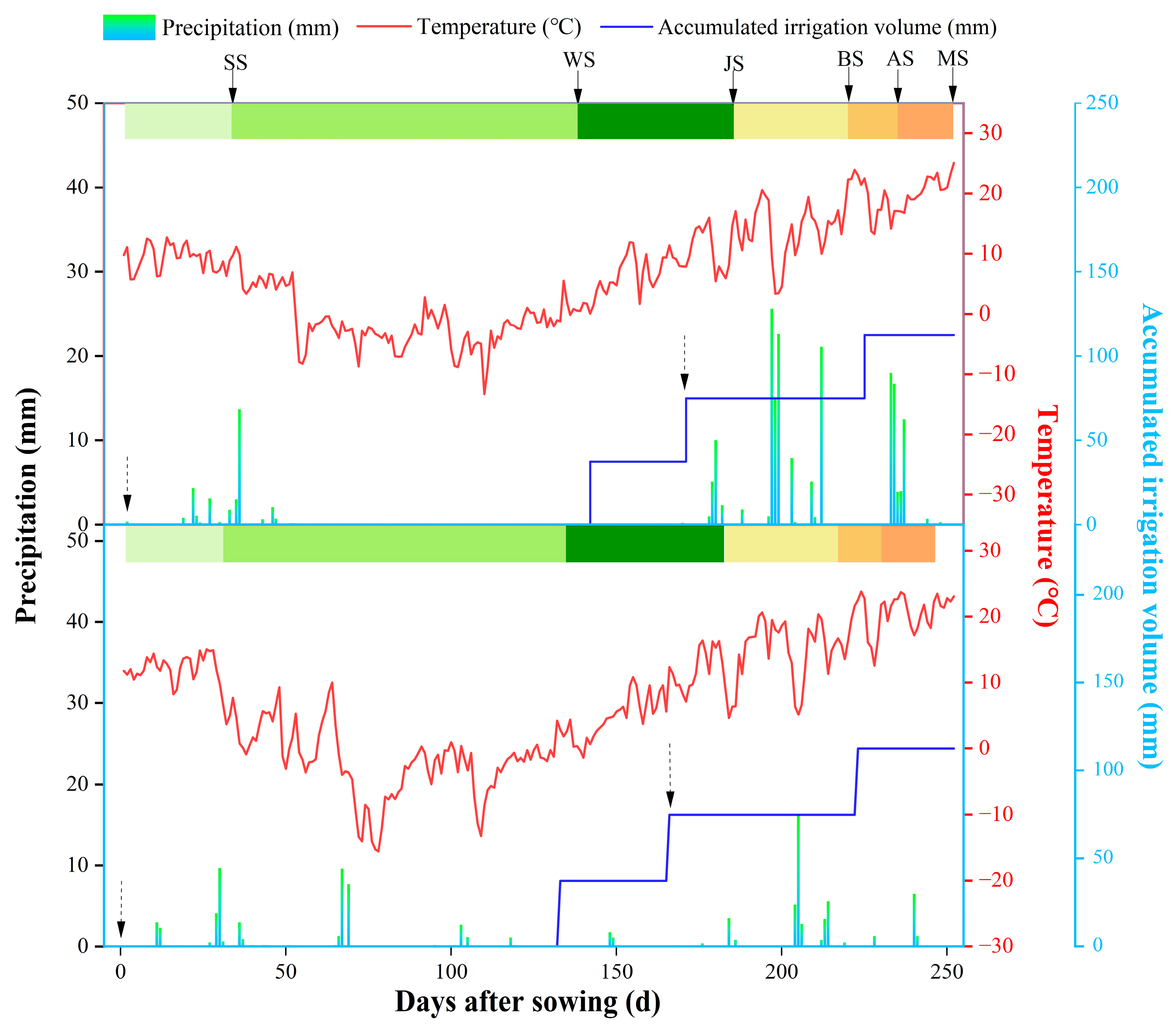
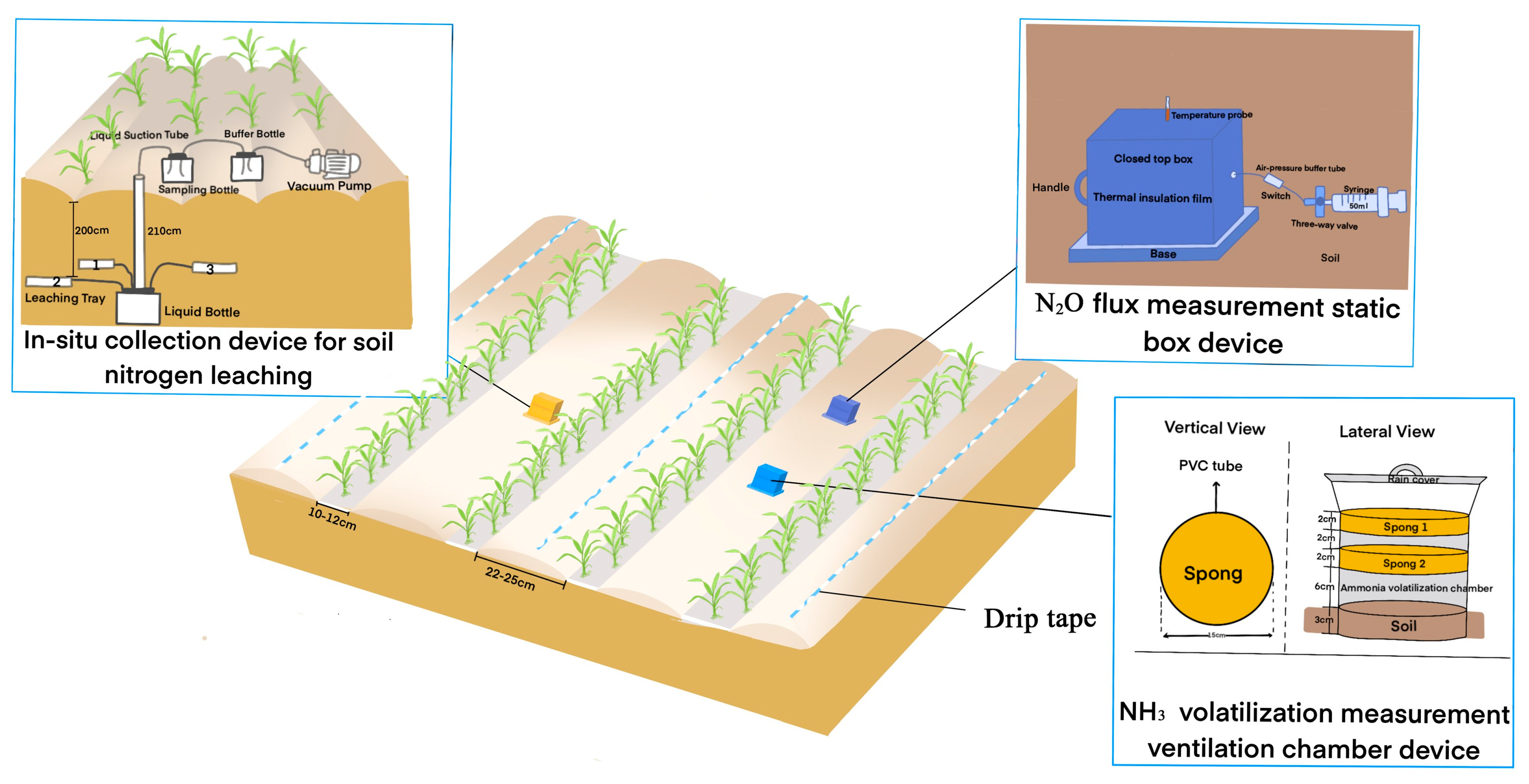
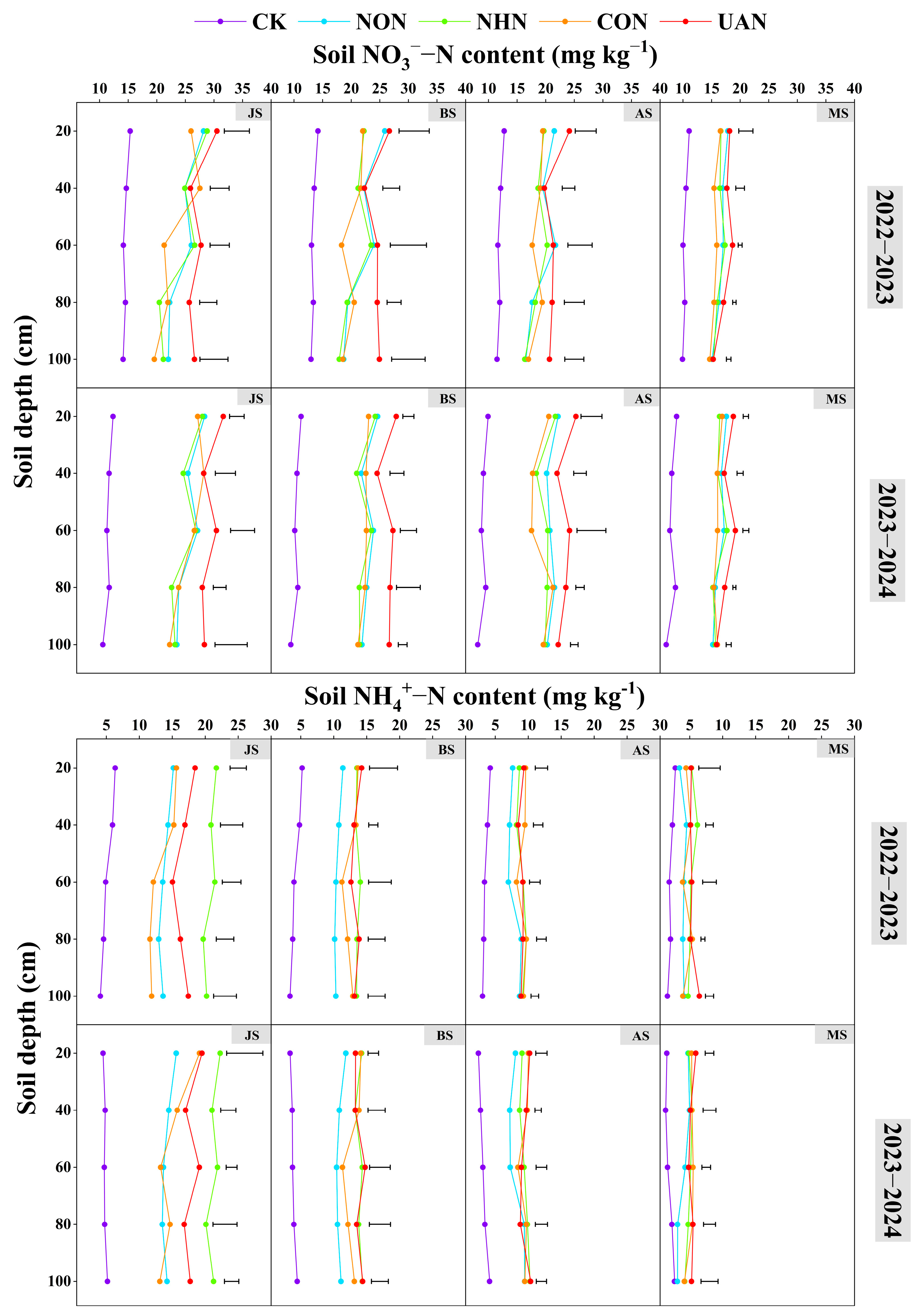
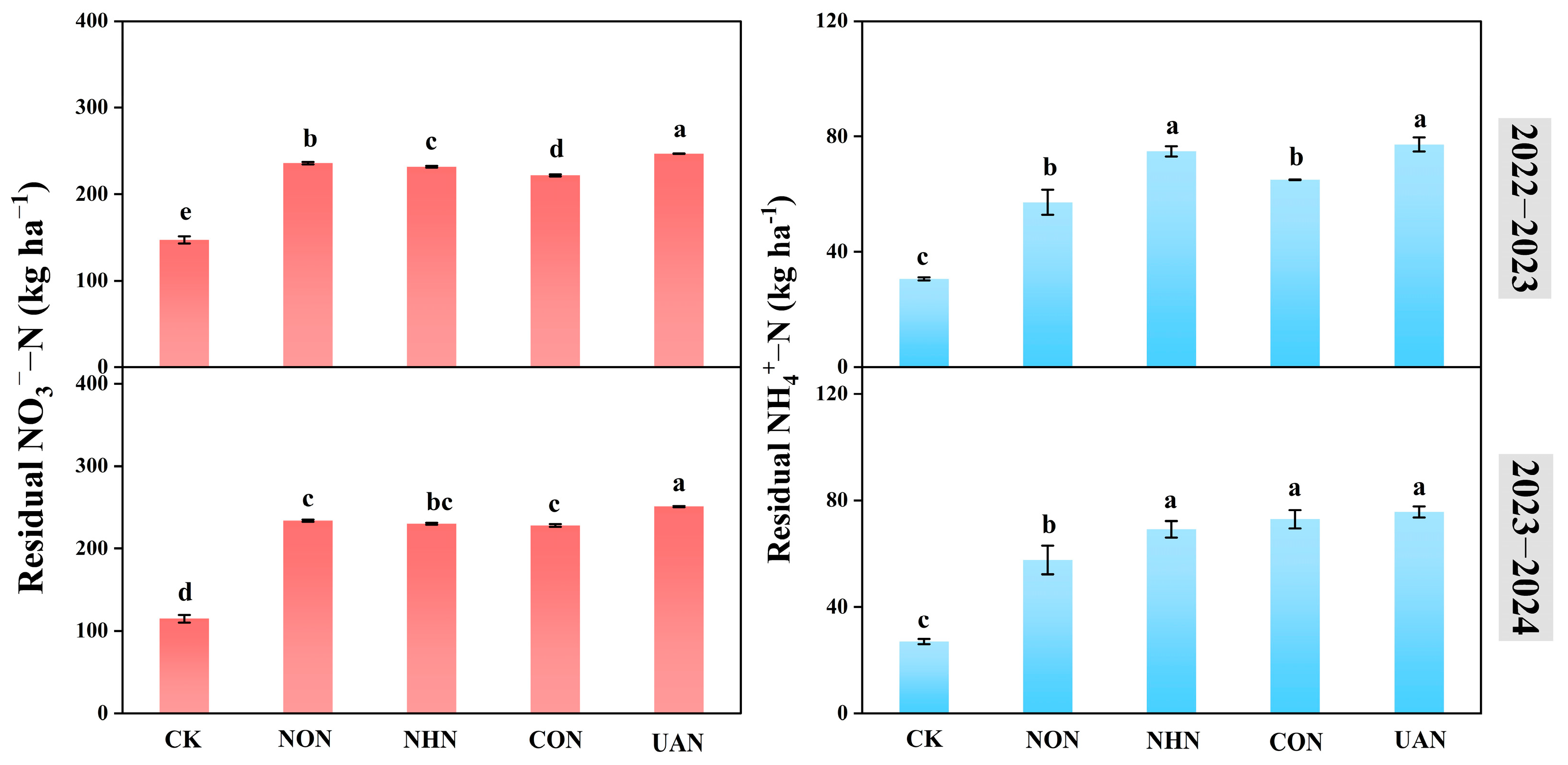

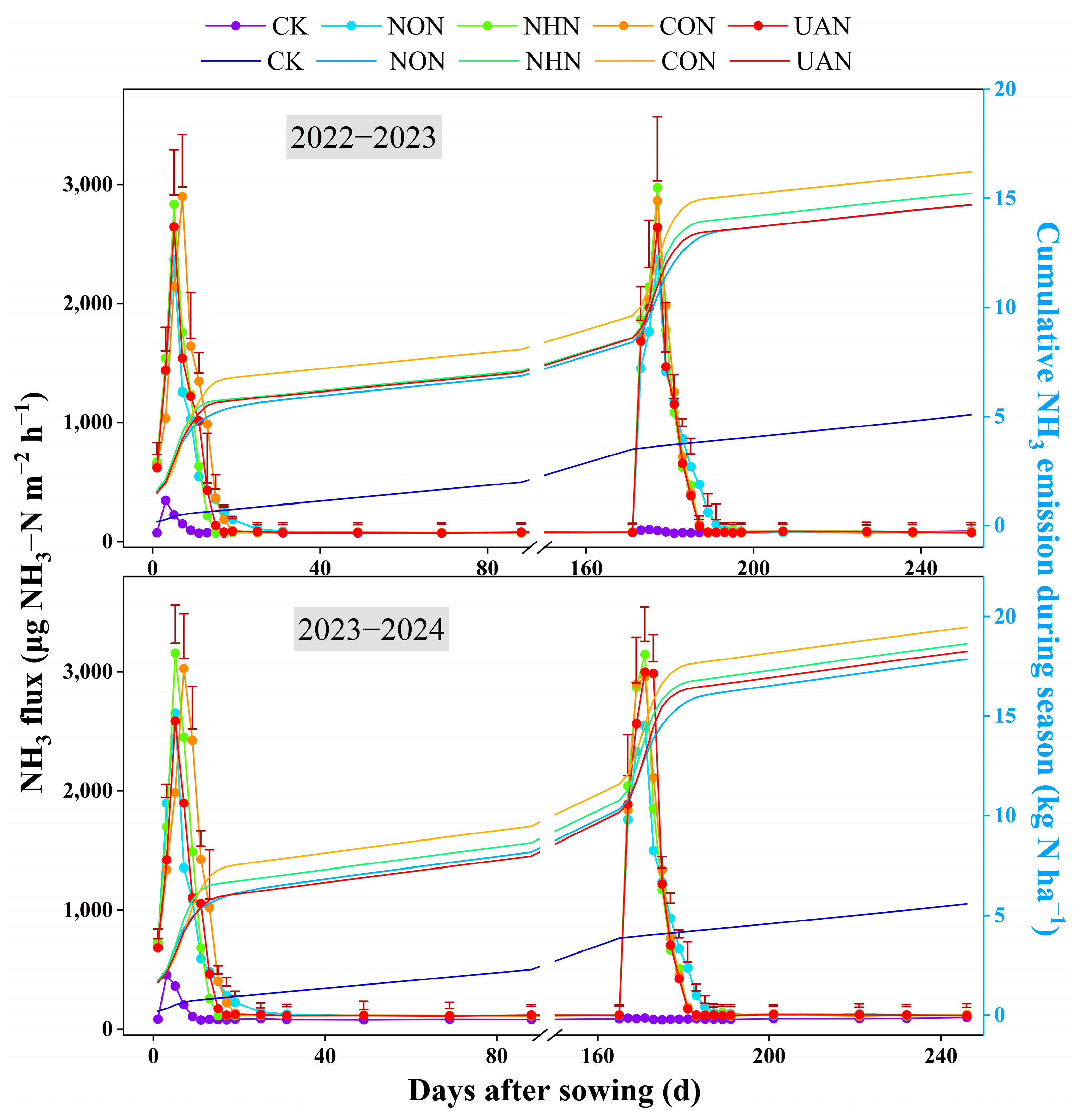

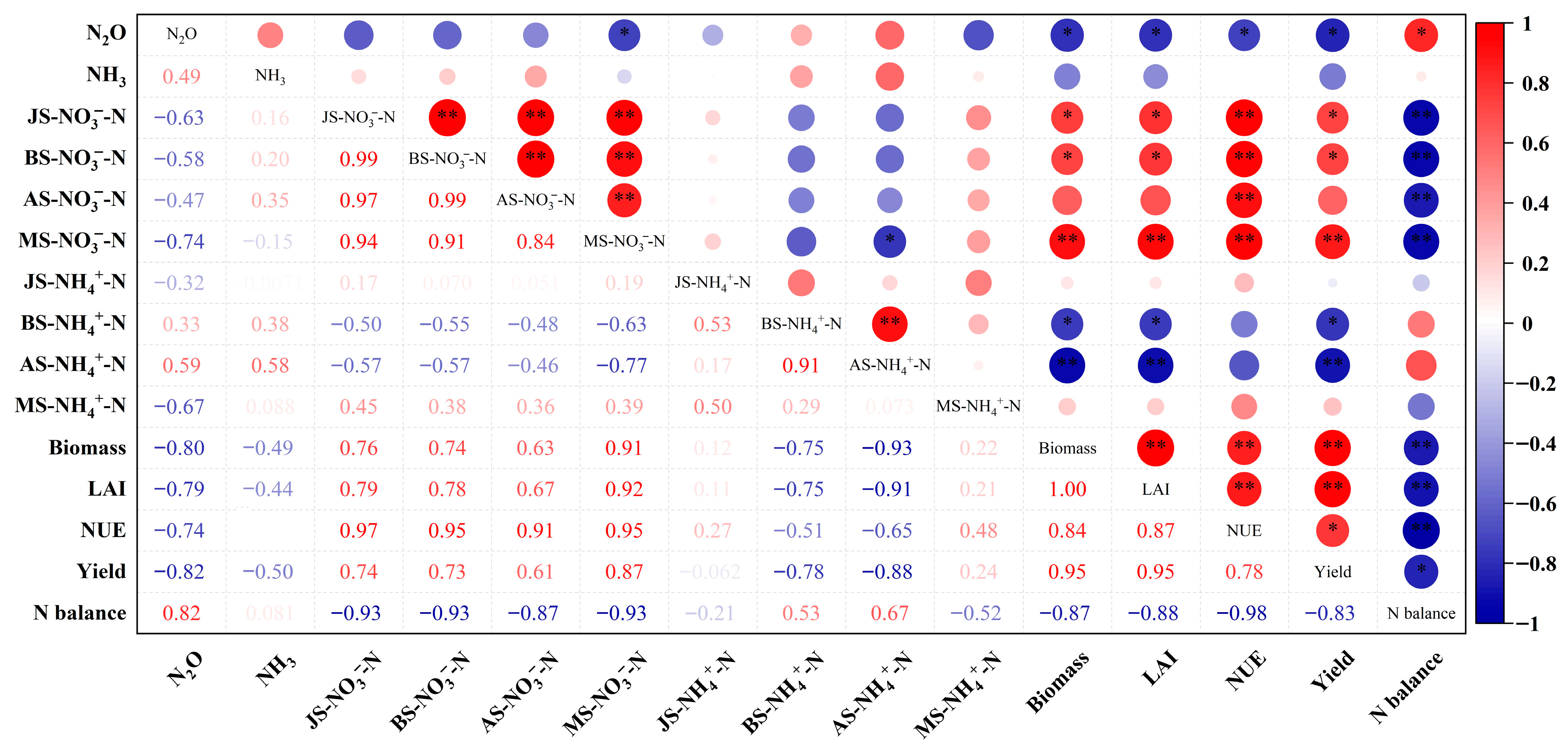
| Year | N Fertilizer Forms | Ear Number (104 ha−1) | Grain Number per Ear | 1000-Grain Weight (g) | Yield (kg ha−1) | HI (%) | NHI (%) |
|---|---|---|---|---|---|---|---|
| 2022–2023 | CK | 408.29 e | 34.23 c | 38.77 b | 7624.28 d | 51.38 d | 49.5 d |
| NON | 643.77 b | 47.24 ab | 47.86 a | 10,846.34 b | 53.94 ab | 62.37 b | |
| NHN | 578.31 c | 45.98 b | 48.34 a | 10,459.32 c | 52.22 bc | 61.58 b | |
| CON | 541.72 d | 44.36 b | 47.25 a | 10,441.34 c | 54.76 cd | 58.39 c | |
| UAN | 684.37 a | 49.57 a | 49.69 a | 11,247.65 a | 53.07 a | 65.91 a | |
| 2023–2024 | CK | 384.21 c | 33.91 c | 37.26 b | 7013.54 d | 50.51 c | 48.77 d |
| NON | 663.13a | 46.28 b | 46.53 a | 10,475.36 b | 52.66 ab | 61.29 b | |
| NHN | 561.32 b | 46.27 b | 46.73 a | 10,157.32 c | 52.03 ab | 60.13 b | |
| CON | 533.73 b | 44.51 b | 46.33 a | 10,146.39 c | 53.42 bc | 56.87 c | |
| UAN | 674.32 a | 49.94 a | 47.71 a | 11,189.31 a | 53.67 a | 64.1 a |
| Year | N Flow | CK | NON | NHN | CON | UAN |
|---|---|---|---|---|---|---|
| 2022–2023 | N input (kg·N·ha−1) | |||||
| Fertilizer N | 0 | 180 | 180 | 180 | 180 | |
| Atmospheric N deposition | 45.46 | 45.41 | 45.57 | 45.20 | 45.59 | |
| Seed N content | 2.25 | 2.25 | 2.25 | 2.25 | 2.25 | |
| Non-symbiotic N fixation | 15 | 15 | 15 | 15 | 15 | |
| Total N input | 62.71 | 242.66 | 242.82 | 242.45 | 242.84 | |
| N output (kg·N·ha−1) | ||||||
| Harvested N removal | 89.37 | 194.51 | 179.35 | 175.28 | 206.37 | |
| Ammonia volatilization N loss | 5.09 | 14.70 | 15.24 | 16.23 | 14.72 | |
| Nitrous oxide N loss | 1.54 | 3.72 | 3.56 | 3.69 | 3.14 | |
| N gas emissions | 5.38 | 13.04 | 12.44 | 12.92 | 11.00 | |
| N leaching | 0.69 | 3.90 | 3.33 | 3.61 | 3.20 | |
| Total N output | 102.06 d | 229.88 b | 213.92 c | 211.74 c | 238.42 a | |
| Soil total N variations (kg·N·ha−1) | −12.69 b | −11.63 ab | −12.38 ab | −14.29 c | −11.25 a | |
| Net N surplus (kg·N·ha−1) | −26.66 e | 48.15 c | 63.47 b | 67.17 a | 36.47 d | |
| N balance (kg·N·ha−1) | −32.66 e | 24.41 c | 41.28 b | 45.01 a | 15.67 d | |
| 2023–2024 | N input (kg·N·ha−1) | |||||
| Fertilizer N | 0 | 180 | 180 | 180 | 180 | |
| Atmospheric N deposition | 45.38 | 45.62 | 45.40 | 45.24 | 45.35 | |
| Seed N content | 2.18 | 2.18 | 2.18 | 2.18 | 2.18 | |
| Non-symbiotic N fixation | 15 | 15 | 15 | 15 | 15 | |
| Total N input | 62.56 | 242.80 | 242.58 | 242.42 | 242.53 | |
| N output (kg·N·ha−1) | ||||||
| Harvested N removal | 76.58 | 184.56 | 177.36 | 172.92 | 198.37 | |
| Ammonia volatilization N loss | 5.59 | 17.86 | 18.64 | 19.48 | 18.26 | |
| Nitrous oxide N loss | 1.43 | 3.92 | 3.75 | 3.88 | 3.36 | |
| N gas emissions | 5.01 | 13.72 | 13.13 | 13.58 | 11.77 | |
| N leaching | 0.59 | 3.77 | 3.18 | 3.57 | 3.27 | |
| Total N output | 89.20 d | 223.84 b | 216.06 c | 213.42 c | 235.03 a | |
| Soil total N variations (kg·N·ha−1) | −10.37 b | −9.24 a | −10.53 b | −13.81 c | −8.61 a | |
| Net N surplus (kg·N·ha−1) | −14.02 e | 58.24 c | 65.22 b | 69.50 a | 44.16 d | |
| N balance (kg·N·ha−1) | −22.27 e | 28.20 c | 37.04 b | 42.81 a | 16.11 d | |
Disclaimer/Publisher’s Note: The statements, opinions and data contained in all publications are solely those of the individual author(s) and contributor(s) and not of MDPI and/or the editor(s). MDPI and/or the editor(s) disclaim responsibility for any injury to people or property resulting from any ideas, methods, instructions or products referred to in the content. |
© 2025 by the authors. Licensee MDPI, Basel, Switzerland. This article is an open access article distributed under the terms and conditions of the Creative Commons Attribution (CC BY) license (https://creativecommons.org/licenses/by/4.0/).
Share and Cite
Hao, R.; Mu, J.; Xie, X.; Ha, Q.; Wang, Y.; Zhai, W.; Wu, P.; Ren, A.; Gao, Z.; Guo, R.; et al. Alteration of Nitrogen Fertilizer Forms Optimizes Nitrogen Balance in Drip-Irrigated Winter Wheat Systems of Northern China by Reducing Gaseous Nitrogen Losses. Agriculture 2025, 15, 2164. https://doi.org/10.3390/agriculture15202164
Hao R, Mu J, Xie X, Ha Q, Wang Y, Zhai W, Wu P, Ren A, Gao Z, Guo R, et al. Alteration of Nitrogen Fertilizer Forms Optimizes Nitrogen Balance in Drip-Irrigated Winter Wheat Systems of Northern China by Reducing Gaseous Nitrogen Losses. Agriculture. 2025; 15(20):2164. https://doi.org/10.3390/agriculture15202164
Chicago/Turabian StyleHao, Ruixuan, Junyi Mu, Xiaoting Xie, Qiqi Ha, Yuanyuan Wang, Wenbo Zhai, Peng Wu, Aixia Ren, Zhiqiang Gao, Ru Guo, and et al. 2025. "Alteration of Nitrogen Fertilizer Forms Optimizes Nitrogen Balance in Drip-Irrigated Winter Wheat Systems of Northern China by Reducing Gaseous Nitrogen Losses" Agriculture 15, no. 20: 2164. https://doi.org/10.3390/agriculture15202164
APA StyleHao, R., Mu, J., Xie, X., Ha, Q., Wang, Y., Zhai, W., Wu, P., Ren, A., Gao, Z., Guo, R., & Sun, M. (2025). Alteration of Nitrogen Fertilizer Forms Optimizes Nitrogen Balance in Drip-Irrigated Winter Wheat Systems of Northern China by Reducing Gaseous Nitrogen Losses. Agriculture, 15(20), 2164. https://doi.org/10.3390/agriculture15202164





